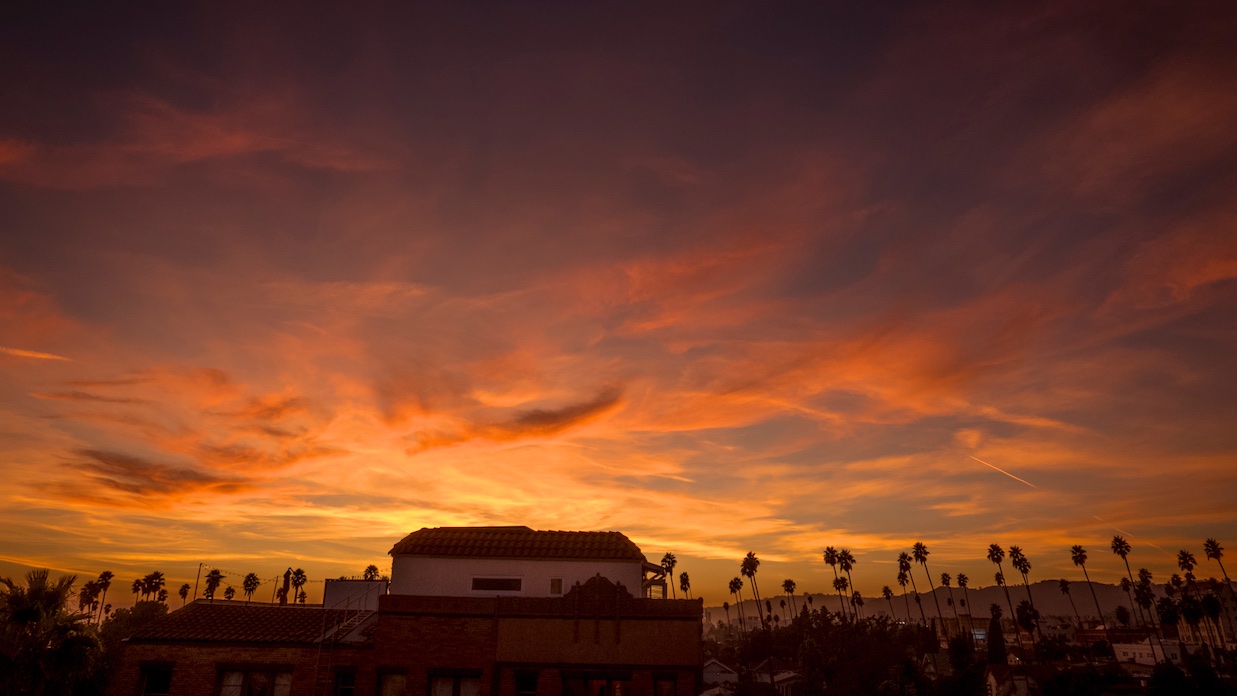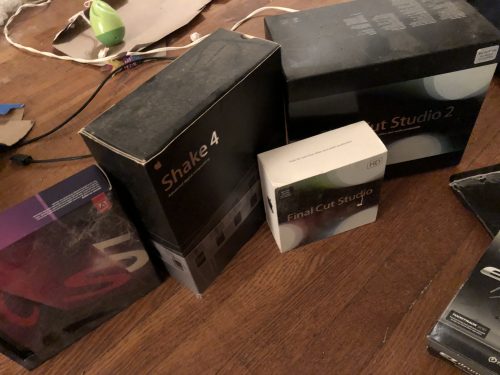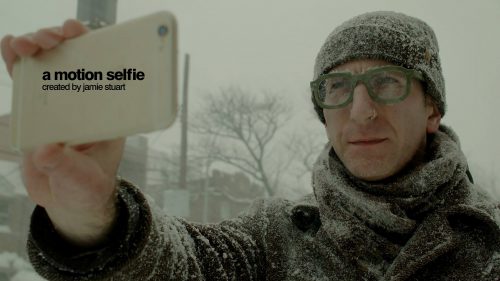 Back to selection
Back to selection
Outside the Box (Or, New York Is Not the Place to Be for Filmmakers Anymore): Jamie Stuart on His Move to LA.
 At home in L.A. (photo: Jamie Stuart)
At home in L.A. (photo: Jamie Stuart) Filmmaker Jamie Stuart has contributed to this publication since the mid-aughts. When he told me he that after completing his NY-set one-man independent feature A Motion Selfie that he’d be moving to L.A., I asked if he’d want to contribute a final Gotham piece in the “Goodbye to All That” genre. Below, he writes about not just his move but the changing independent film culture in New York over the past decade-plus. — SM
The day before the move was literally the worst day of my entire life.
Popping half tabs of Valium every five hours, I spent 7:00 AM until midnight packing, shipping and gutting my apartment of 11 years — often making split decisions about what sentimental artifacts I could keep, and which 25 year-old possessions had to be let go of. By the time midnight hit, I could no longer function. I needed one more day to finish clearing the box studio, and I didn’t have it — this wasn’t a local move, I was relocating across the country.

The apartment was a disaster. Bed still there. Desk still there. Cabinets full. Debris everywhere. Sitting on the bathroom floor, I pathetically scribbled a note on a piece of cardboard apologizing to the super, then clipped $40 to it and left it outside his door.
At 5:00 AM, it was time to leave for the airport. I was such a colossal mess that after I brought the first bag outside, I realized I’d left my keys with the cardboard scrawl and locked myself out — two bags still in the lobby, including the cat carrier. So I actually called the super, woke him up and asked him to buzz me back in.
I first moved to New York City in May 1996, after the first 20 years of my life imploded under the weight of my parents’s divorce. I considered going to LA at the time but went with NYC instead because I had friends there.
This was the mid-’90s, and indie film was hot shit. NYC was supposedly the place to be. I wound up as part of a loose group of former New York Film Academy students (I had taken two workshops there right out of high school), and we all expected to easily get our movies made.
I completed a terrible short film in 16mm. It cost about $10,000 to take through to an answer print. It was only 20 minutes long. As many of my similarly ambitious friends did as well, I realized I was fucked.
That’s how it worked back then: you’d would save up, and you’d have one shot, because it cost too much to do it again. If you blew it, that was it.
My first apartment was in Astoria. That’s where everybody went to get a $500 studio in a safe area near Manhattan. By ’98, everybody was headed to Brooklyn, and it broke down like this: if you had a little money, you went to Park Slope; if you didn’t have any money, you went to Williamsburg. I wound up in Windsor Terrace, about a block from where Dog Day Afternoon was shot. Rent was $875 for a one-bedroom.
Due to the prohibitive prices of filmmaking, I went nearly six years without completing a single film. I continued writing scripts, and even storyboarded one shot-for-shot. But this was a total dead zone for me. I was briefly represented as an illustrator, hoping I could earn enough to fund a movie, but that never quite worked out.
In theory, this should’ve been the end.
But then, at age 26, I got my first legit foot in the door of the film world, when Jami Bernard, chief film critic at the New York Daily News, hired me as her one-day-a-week assistant. I got to go to press screenings (Apocalypse Now Redux, A.I.: Artificial Intelligence), and I even got to meet Christiane Kubrick and Jan Harlan at the Lincoln Center premiere of Stanley Kubrick: A Life in Pictures.
In September, only a week after 9/11, I began production on my first new short since ’96, called Triumph of the Will, Part II (it had nothing to do with Nazis). Rain cut our final day of exteriors short, and we made plans to finish at a later date.
I shot on 16mm black & white, with the intention of cutting it old school on a Steenbeck, just to show that in the world of AVID, it could still be done. Of course, by the time we finished shooting in December, I’d run out of money and finished it on Mini-DV, and then I edited the whole thing on my laptop using a bootleg copy of Final Cut Pro 2.
The movie was half 16mm, half DV. Born at the tail end of Gen X, I always said I landed right on the fault line between analog and digital — and I now had a visual document of my filmmaking transition from one to the other.
I have never gone back to shooting film.
A year after finishing Triumph, I made a 20-minute DV short for $50. In the subsequent decade, I created over 200 digital shorts, many with budgets hovering near $0.
After spending six months technically homeless, including the completely freaky post-9/11 winter, I landed in Greenpoint, which, as it buttressed Williamsburg, was also considered cool. I was 27, and my roommates were all college seniors. Rent was $800 for a bedroom.
The following five years were horribly difficult — however, having started working online and embracing digital DIY, I was at least happy to be creating.
This period began by managing a movie website with a friend called MovieNavigator.org, for which I contributed interviews with filmmakers and actors. The website died around the time that broadband exploded (I again briefly considered an L.A. move), so I combined my press contacts with my filmmaking and carved out a niche where I’d make creative short films that blended documentary footage with fiction.
Starting over again as a fully-committed filmmaker, I was so broke that I wound up back in Astoria, crashing on a friend’s floor (I didn’t even have an active bank account).
My first web series, shot in 2004, at the New York Film Festival, was done independently but had gotten a ton of exposure thanks to Movie City News reposting the links to my videos. A year later, I did a series called Mutiny City News for MCN. A year after that, I effectively became the filmmaker-in-residence at Filmmaker, and I soon headed to Sundance for my first time.
During this phase, I was rising parallel to mumblecore. They played festivals, while I stuck to the web. They preferred rudimentary filmmaking, I was big on technique. They stuck with realism, I fucking hated reality. Also, on average, I was five-to-six years older than they were.
By the time I moved into my box studio in Astoria, in late ’07, I was already 32-years old. The job that paid for my move was Focus Features, which had sent me to Toronto to create a series of promos for their fall films. My rent was $950, roughly $200 less than market value, because it hadn’t been renovated.
Within a year of moving in, the economy collapsed, and jobs that had once paid $1,800 were chopped down to $250. I eventually wound up on food stamps.
So here I was, a working filmmaker, meeting lots of other great established filmmakers and actors, and with work that was getting good exposure — but no matter what I did, I could never get a feature produced. My stuff was just too weird. It didn’t fit the aesthetic mold of “indie film.”
Every major NYC producer looked at my scripts and met with me — but they all passed, over and over. Even if they liked the project, it just wasn’t necessarily the type of thing they personally produced. Meanwhile, the mumblecore group was slowly working its way to legitimacy — because they had no access to high-level industry types, they cobbled together momentum on their own.
My life changed drastically on December 28th, 2010, when Roger Ebert wrote that my quickie short film documenting a massive blizzard, Idiot with a Tripod, should win an Academy Award. I was momentarily famous, appearing on the Today Show and ITV, among others. I’d step onto the subway and somebody would shake my hand.
Again, I almost went to LA at this point, after a director friend tried to convince his commercial rep to sign me. But being that the company was too large to break new talent into that game, I was steered to a NYC boutique instead.
Everything was great at first: not only did the commercial company get me a job quickly, but lots of people I already knew in the NYC indie community began hiring me as well. I had a good year and a half, and then, in mid-2012, the engine stalled, and it was a slow descent from there. I had planned to move out of the box studio if I had enough saved by the fall — and that had to be put on hold.
Basically, everything that I’d gotten out of the brief fame was a bad fit. I was at the wrong company, and they didn’t know how to sell me. A lot of people thought I was a documentary filmmaker (which I wasn’t), so I kept getting hired to shoot boring interviews and b-roll. Plus, all of those indie jobs that mushroomed were mostly low quality, so even though I was working, I didn’t have good work to show for it.
And to top it off, the movie I’d been trying to get made for six years finally crashed and burned.
By the time the dust settled, it was early 2013, and I was nearly 38. I was stuck in the box studio in Astoria as rising rents were devouring the city. My career, which I’d been busting my ass at for years, was at a complete standstill. I couldn’t go back to the no-pay work I was doing pre-Idiot, but I couldn’t jump to a new commercial company because the one I was at had never gotten me any real work. Plus, I still couldn’t get a feature made. I was completely neutralized.
By this time, filmmakers I’d known for years were pulling ahead, getting real budgets, even starting to dabble in studio work. (When I did Mutiny City News, in ’05, I remember a flabbergasted David Lowery asking me how I got that — and now I was shaking his hand and congratulating him as he exited a Q&A screening of Ain’t Them Bodies Saints at FSLC.)
After giving it all a lot of thought, I decided to focus on a novel idea: the one thing I did as a filmmaker that nobody could compete with was DIY shooting. I had developed a style over the years where I both shot and starred in my films simultaneously. The goal was now to create a no-budget feature with this approach. A movie made without anybody else’s permission.
Twenty years of frustration and inspiration were squeezed into a completely original 90-minutes called A Motion Selfie.

The movie was my entire life from 2015 through mid-2018. Everything else was on hold. Upon completion, I could start walking again. And I very quickly realized it was time to get out of the box.
But where to? The only thing I could afford in NYC would be the same neighborhood, and I’d likely be paying more. Because of rent regulations, I was paying $1,176 for an apartment with a market value of at least $1,500. I wasn’t interested in a lateral move.
Since A Motion Selfie went straight to the web and didn’t play the festival circuit, my only other option was Los Angeles, which I’d visited shortly after finishing the movie, toward the end of ’17, to interview a few cast members who’d made the move since we shot in ’15.
I’d always hated LA. But I actually had a good time during my visit. I had friends and a few starter contacts. So that became the play.
I spent three months meticulously planning and budgeting the move. And as soon as I started executing the plan, everything went to hell — it was three weeks of running around like a madman, spending twice what I’d imagined. I could probably write an entire essay about the move itself, which even included my new neighbors vulturing a few Ikea items I left in the lobby after going to move the van I rented.
New York is definitely not the place to be anymore, if you’re an aspiring filmmaker. It’s fine if you’re interested in documentaries and TV, but not features. Especially creative features. The city’s film world is essentially run by a cartel of non-profits — film societies, grant organizations, labs, etc. It’s a system, made up of mostly good people. But it’s a system, nonetheless. And like all systems, it tends to homogenize.
As I met with friends before leaving, I realized how many of them were trapped by rent as well. So many people had leased apartments before the price spike and were now prisoners.
Getting out of NYC took everything I had — emotionally, physically and financially.
I’m adjusting to my new life in LA. Another studio, for $1,300, and it’s got way more space than my old box. I’m enjoying the change so far, and I really love the light — some strange alchemy of smog and desert that makes even the hardest light look soft.
Just as I was starting to relax, a friend emailed to say: “Welcome to LA. Just remember, everyone here is out to fuck you.”
I replied: “Can I trust you???”
“Of course not.”
